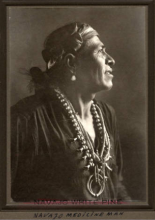Medicine man is an Anglicized term that refers to traditional Native American healers. However, each tribe has unique understandings about the roles and responsibilities of their healers, who may also double as spiritual leaders. In the Navajo culture, there are four categories of healers: listeners, hand tremblers, and stargazers, who may be consulted about sickness, identifying witchcraft, dreams, lost items or any unusual happenings. But it is the haatali, or singer, who fills the position of medicine man in Navajo culture.
Traditionally called a haatali, or "singer," in Navajo, this healer performs ceremonial cures that are targeted at body, mind, and spirit. There are nearly 100 Navajo chants of varying range and intricacy. Originating from the Navajo Creation Story, they are so nuanced and complex that a medicine man learns only one or two sings over many years of apprenticeship. Ceremonies last anywhere from one to nine days and include chants, songs, prayers, lectures, dances, sweat baths, prayer sticks, and sand paintings. In order for a ceremony to be effective, everything must be done as prescribed in the legends.
"White Pine, a Navajo Medicine Man, circa 1890." William A. Keleher Collection (000-742-0352.tif). Center for Southwest Research, University of New Mexico.
Beck, Peggy V. and A.L. Walters
1977 The Sacred: Ways of Knowledge, Sources of Life. Tsaile: Navajo Community College
Press.
Frisbie, Charlotte J.
1987 Navajo Medicine Bundles or Jish: Acquisition, Transmission, and Disposition in the
Past and Present. Albuquerque: University of New Mexico Press.
Hirschfelder, Arlene and Paulette Molin
2000 Encyclopedia of Native American Religions. New York: Checkmark Books.
Levy, Jerrold and Raymond Neutra, Dennis Parker
1987 Hand Trembling, Frenzy Witchcraft, and Moth Madness. Tucson: University of
Arizona Press.

